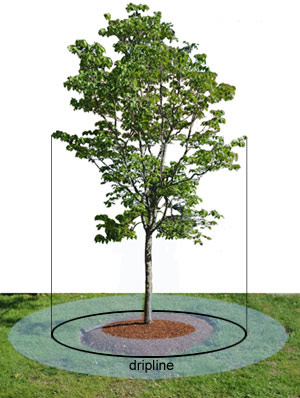Tree dripline
The dripline is the guide measurement used to prevent unnecessary damage to trees during construction works. It is defined as the outermost circumference of the tree’s canopy, from which water drips onto the ground. The ‘dripline area’ is taken to include the soil and roots that lie within that circumference.
It is crucial for the stability and health of a tree that the dripline area is ‘off limits’ from any construction activity. It may be necessary to erect a fence around the dripline or, if possible, further out around groups of trees so as to prevent their roots from being damaged by construction plant, or by works such as excavation, soil compaction or consolidation. Fences should remain in place until all construction work is complete, including the final grading and smoothing of the site.
If work inside the dripline is unavoidable, only hand tools should be used. Where possible, tunnels should be excavated beneath the root system as opposed to trenching. Other measures that can be adopted to avoid undue damage include:
- Using porous paving materials such as brick or flagstone rather than concrete or asphalt.
- Not raising the grade of the soil inside the dripline by more than a few inches.
- Not lowering the grade of the soil inside the dripline by more than 2 inches.
- Not piling soil or construction materials inside the dripline, even for a short period of time.
[edit] Find out more
[edit] Related articles on Designing Buildings Wiki
Featured articles and news
One of the most impressive Victorian architects. Book review.
RTPI leader to become new CIOB Chief Executive Officer
Dr Victoria Hills MRTPI, FICE to take over after Caroline Gumble’s departure.
Social and affordable housing, a long term plan for delivery
The “Delivering a Decade of Renewal for Social and Affordable Housing” strategy sets out future path.
A change to adoptive architecture
Effects of global weather warming on architectural detailing, material choice and human interaction.
The proposed publicly owned and backed subsidiary of Homes England, to facilitate new homes.
How big is the problem and what can we do to mitigate the effects?
Overheating guidance and tools for building designers
A number of cool guides to help with the heat.
The UK's Modern Industrial Strategy: A 10 year plan
Previous consultation criticism, current key elements and general support with some persisting reservations.
Building Safety Regulator reforms
New roles, new staff and a new fast track service pave the way for a single construction regulator.
Architectural Technologist CPDs and Communications
CIAT CPD… and how you can do it!
Cooling centres and cool spaces
Managing extreme heat in cities by directing the public to places for heat stress relief and water sources.
Winter gardens: A brief history and warm variations
Extending the season with glass in different forms and terms.
Restoring Great Yarmouth's Winter Gardens
Transforming one of the least sustainable constructions imaginable.
Construction Skills Mission Board launch sector drive
Newly formed government and industry collaboration set strategy for recruiting an additional 100,000 construction workers a year.
New Architects Code comes into effect in September 2025
ARB Architects Code of Conduct and Practice available with ongoing consultation regarding guidance.
Welsh Skills Body (Medr) launches ambitious plan
The new skills body brings together funding and regulation of tertiary education and research for the devolved nation.
Paul Gandy FCIOB announced as next CIOB President
Former Tilbury Douglas CEO takes helm.























